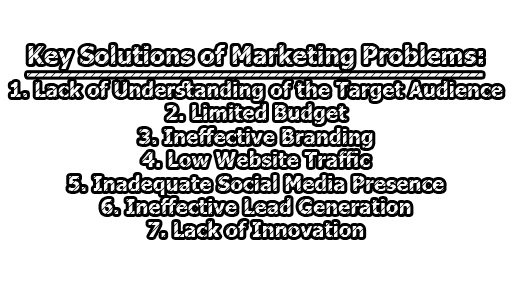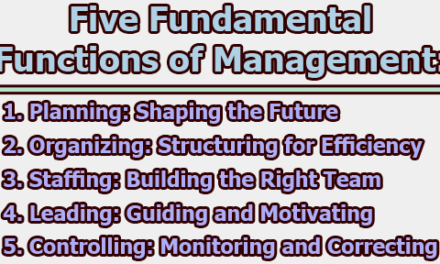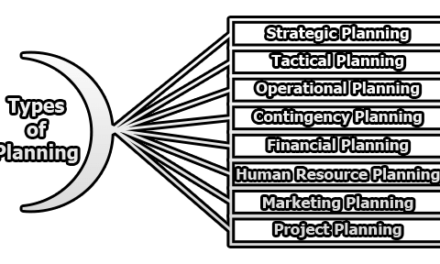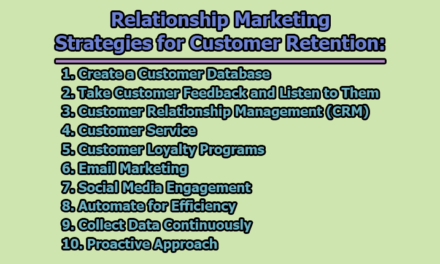Key Solutions to Marketing Problems:
Marketing is the lifeblood of any business. It is the process of promoting, advertising and selling products or services to potential customers. It is an essential function for businesses to create brand awareness, generate leads, and boost sales. However, marketing also has its challenges, and businesses often struggle to overcome these problems. In this article, we will discuss some key solutions to marketing problems that businesses face.
- Lack of Understanding of the Target Audience:
One of the most common marketing problems that businesses face is a lack of understanding of the target audience. Businesses must know their target audience’s needs, wants, and pain points to create an effective marketing strategy. To overcome this problem, businesses should conduct market research to gather information about their target audience. This can be done through surveys, focus groups, and social media listening.
Market research helps businesses identify their target audience’s demographics, interests, behaviors, and preferences. This information can then be used to create a buyer persona, which is a fictional representation of the ideal customer. By understanding their target audience better, businesses can tailor their marketing messages and strategies to resonate with them, leading to higher engagement and conversions.
- Limited Budget:
Marketing requires a budget, and businesses often struggle with limited resources. They may not have the funds to invest in expensive marketing campaigns or hire a full-time marketing team. However, there are several cost-effective marketing strategies that businesses can use to overcome this problem.
Content marketing is one such strategy. It involves creating valuable and informative content that attracts and engages potential customers. This can be done through blog posts, videos, infographics, and social media posts. Content marketing is relatively inexpensive and can be done in-house or outsourced to a freelancer.
Another cost-effective marketing strategy is email marketing. It involves sending targeted and personalized emails to potential and existing customers to nurture leads and drive sales. Email marketing tools like Mailchimp and Constant Contact are affordable and easy to use, making it an excellent option for businesses with limited budgets.
- Ineffective Branding:
Branding is crucial for businesses to stand out from their competitors and create a unique identity in the minds of customers. However, businesses often struggle with ineffective branding, which can lead to confusion and low brand recognition.
To overcome this problem, businesses should develop a clear and consistent brand identity. This includes defining their brand values, mission, vision, and personality. Businesses should also create a brand style guide that outlines the visual elements of their brand, including the logo, colors, typography, and imagery.
Consistency is key to effective branding. Businesses should ensure that their brand messaging and visual elements are consistent across all marketing channels, including their website, social media, and advertising campaigns. This will help customers recognize and remember the brand, leading to increased brand loyalty and advocacy.
- Low Website Traffic:
Websites are essential for businesses to showcase their products or services and convert visitors into customers. However, businesses often struggle with low website traffic, which can lead to low conversions and sales.
To overcome this problem, businesses should invest in search engine optimization (SEO). SEO involves optimizing the website’s content and structure to rank higher in search engine results pages (SERPs). This can be done through keyword research, on-page optimization, and link building.
Another way to drive website traffic is through content marketing. By creating valuable and informative content, businesses can attract potential customers to their websites and increase their visibility in search engines. This can also help establish the business as a thought leader in the industry, leading to increased credibility and trust.
- Inadequate Social Media Presence:
Social media is a powerful marketing tool for businesses to reach and engage with their target audience. However, businesses often struggle with an inadequate social media presence, which can lead to low engagement and visibility.
To overcome this problem, businesses should develop a comprehensive social media strategy. This involves choosing the right social media platforms based on their target audience’s demographics and interests, creating engaging and shareable content, and engaging with their followers.
Businesses should also use social media analytics tools to track their social media performance and optimize their strategy accordingly. This includes tracking metrics such as reach, engagement, and conversions.
In addition, businesses should consider investing in social media advertising. This can help increase their reach and visibility and target their ads to specific demographics and interests.
- Ineffective Lead Generation:
Lead generation is the process of attracting and converting potential customers into leads. However, businesses often struggle with ineffective lead generation, which can lead to low sales and revenue.
To overcome this problem, businesses should create a lead generation strategy that includes a clear value proposition and compelling call-to-action. This can be done through landing pages, webinars, e-books, and other lead magnets that provide value to potential customers.
Businesses should also implement lead scoring and nurturing processes to prioritize and engage with their leads effectively. This involves tracking the leads’ behavior and interests and sending them targeted and personalized content based on their stage in the buyer’s journey.
- Lack of Innovation:
Marketing is an ever-evolving field, and businesses must continually innovate to stay ahead of their competitors. However, businesses often struggle with a lack of innovation, leading to stagnant growth and low market share.
To overcome this problem, businesses should invest in research and development (R&D) to create innovative products or services that meet their target audience’s needs and wants. They should also continually monitor their competitors and market trends to identify new opportunities and adapt their strategies accordingly.
Businesses should also encourage a culture of innovation within their organization. This includes promoting brainstorming and idea-sharing sessions, rewarding creativity and risk-taking, and providing resources and support for employees to pursue innovative projects.
From the above discussion, we can say that marketing is essential for businesses to attract and retain customers, drive sales, and achieve growth. However, marketing also has its challenges, and businesses must overcome them to succeed. By understanding their target audience, developing a clear brand identity, investing in cost-effective marketing strategies, and continually innovating, businesses can overcome these challenges and achieve their marketing goals.
References:
- “10 Social Media Marketing Strategy Tips for 2021” by Sprout Social: https://sproutsocial.com/insights/social-media-marketing-strategy/
- “10 Tactics for Improving Your Customer Retention Strategy” by Entrepreneur: https://www.entrepreneur.com/article/313398
- “10 Best Lead Generation Strategies for 2021” by Digital Marketing Institute: https://digitalmarketinginstitute.com/blog/10-best-lead-generation-strategies-for-2021
- “4 Tips for Maintaining Consistent Brand Messaging Across Platforms” by Hootsuite: https://blog.hootsuite.com/consistent-brand-messaging/
- “5 Effective Customer Retention Strategies for 2021” by Hubspot: https://blog.hubspot.com/service/customer-retention-strategies
- “7 Reasons Your Content Marketing Strategy Isn’t Working (And How to Fix It)” by Content Marketing Institute: https://contentmarketinginstitute.com/2018/06/content-marketing-strategy-not-working/
- “How to Build a Strong Brand Identity” by Forbes: https://www.forbes.com/sites/forbesagencycouncil/2021/01/20/how-to-build-a-strong-brand-identity/?sh=69c8e3136dc2
- “How to Develop a Content Marketing Strategy in 2021” by Hubspot: https://blog.hubspot.com/marketing/content-marketing-strategy
- “How to Encourage Innovation Within Your Business” by Harvard Business Review: https://hbr.org/2019/09/how-to-encourage-innovation-within-your-business
- “The Beginner’s Guide to SEO” by Moz: https://moz.com/beginners-guide-to-seo
- “The Definitive Guide to Social Media Marketing” by Neil Patel: https://neilpatel.com/what-is-social-media-marketing/
- “The Importance of Innovation in Business” by Investopedia: https://www.investopedia.com/articles/financial-theory/08/innovation-business.asp
- “The Importance of Understanding Your Target Audience for Effective Marketing” by Hubspot: https://blog.hubspot.com/marketing/target-audience
- “Why Brand Identity Matters and How to Create a Strong One” by Hootsuite: https://blog.hootsuite.com/brand-identity/
- “Why Consistency Is Key to Effective Brand Messaging” by Forbes: https://www.forbes.com/sites/forbescommunicationscouncil/2020/08/05/why-consistency-is-key-to-effective-brand-messaging/?sh=284c5633b3e8
- “Why Understanding Your Target Audience is Vital for Successful Marketing” by Forbes: https://www.forbes.com/sites/forbesagencycouncil/2021/05/21/why-understanding-your-target-audience-is-vital-for-successful-marketing/?sh=65f8d3f53519

Library Lecturer at Nurul Amin Degree College










